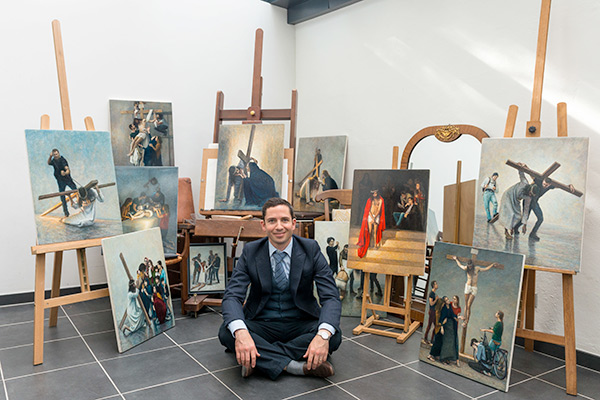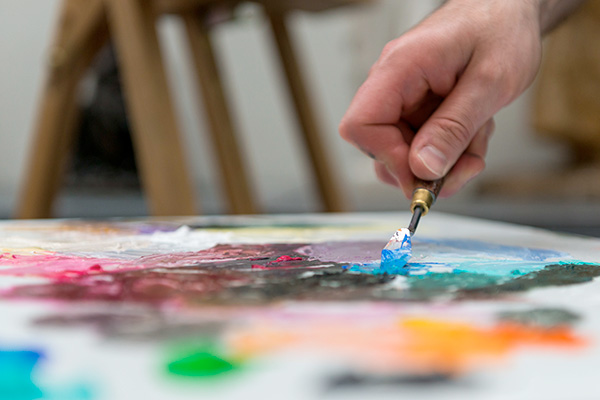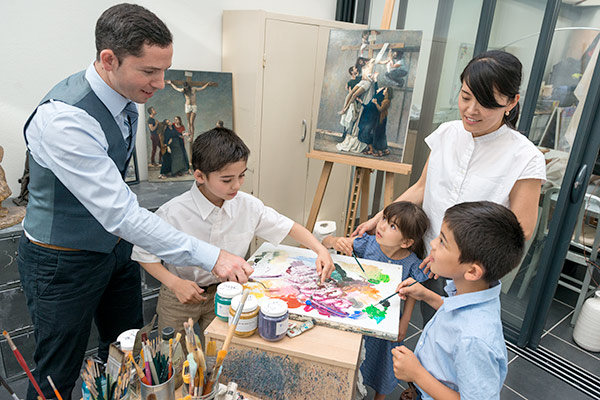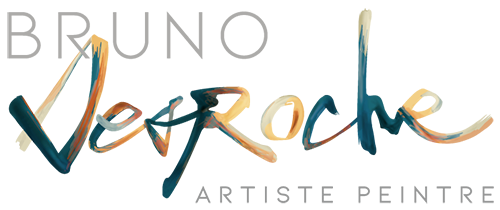BIOGRAPHY
BRUNO DESROCHE
A vocation anchored through a broken ankle
Born September 21, 1979, Bruno is the second of nine children. He grew up in Haute-Savoie where his father worked as a cardiologist. He catches the taste for drawing as a child, with in particular an epistolary game of letters and drawings with his paternal grandmother. His vocation took root at the age of 15 thanks to a bicycle accident, when he would have his ankle broken and found him nailed on the spot on the first day of the summer holydays in Sables-d’Olonne in Vendée.
A drawing course could be found In extremis for him; he spots on, a young boy in the midst of an assembly of elderly ladies, only to find a bohemian but demanding lady teacher who will give him, throughout this summer, the first keys to different drawing techniques.
A painter, a friend of his grandparents who would happen to stay there that summer, encourages him at the sight of his first drafts. For him there is no longer any doubt: this is the job he wants to do.
His parents will not distract him from this vocation but altogether want the best for him. His father brings in as many school leaflets as possible. At the start of the school year, still plastered, he stays as an intern at the Chartreux in Lyon, and makes friends with Laurent, his dorm supervisor, a student in journalism and a comics enthusiast. He is the one who will tell him about the Emile Cohl school, whose resolutely academic approach to the representation of reality will seduce the young Bruno. Be able to enter this school will then be a decisive motivation during all of his high school years.
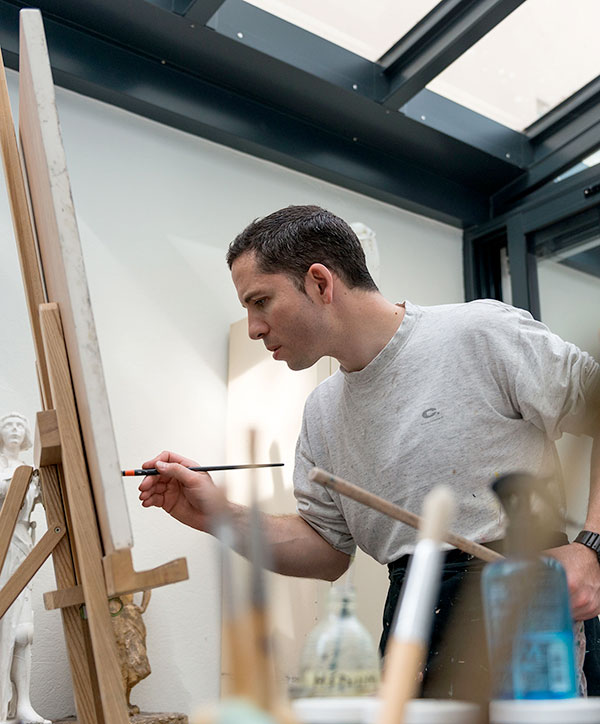
Learning and transmission at Emile Cohl school
He enters the school in 1997 after his baccalaureate. His mentor there will be a woman, Danièle Blot-Ducreux, who will transmit him, in addition to the basics of the craft and the most precise techniques, her transcendental vision of the representation of reality.
A few years later, she would sponsor him to take over from her and become a teacher at this school.
Before that, he will make his living as a contemporary painter by exhibiting in different galleries in Lyon (Gilles Febvre, Patrick Pons, Talents to follow, Art Club …), giving private lessons, winning tenders;
From September 2002 to spring 2003, he has spent the winter on the island of Groix (Brittany). Struggling against the loneliness, and against the headwinds which would slow down his bicycle loaded with painting equipment. There he gets inspired by the maritime winter landscapes, which he will paint passionately.
There alors he meets and "falls in friendship" with the Baron family, descends of tuna fishermen and fishermen themselves, who will allow him, through their support and good food, to get through this exciting and formative winter, which was also an ordeal.
Back to Lyon then, in search of his vocation, and back to teaching with the invitation to take over from his master in drawing, Danièle Blot-Ducreux. In 2007, he will teach integrated prep courses (around thirty students), then will be in charge of the first year of the school in 2009 (up to 290 students in his own), to teach them the basics of still life and ancient drawing. He continues to paint and exhibit landscapes, particularly in Haute-Savoie and Savoie (his largest exhibition will be at the Vaugelas chapel in Chambéry in October 2009, where he will expose 56 paintings, an exhibition which will be a great success).
To Paint his human brothers
The desire to deepen the meaning of his art, to weave his fiery faith with his paintings, leads him on different tracks: from monoliths to geometric abstraction. But he remains unsatisfied. In the deep of himself, he feels that there is nothing more beautiful and more perfect than the human figure.
Begins then a path of humility.
It is really Man and more precisely his contemporaries that he wants to paint. His passion for great painters (Pietro Della Francesca, Caravaggio, Bruegel) will guide him from now on. Up to him now, to represent his contemporaries in biblical scenes! But He needs models for this. With the help of Lilas, one of his former students, who has also become a painting teacher, he calls on his students, former and current. Two paintings will be born from this impulse: a “Christ aux outrages” (mocked Christ)and a pietà. The two will be offered from the whole parish as a departure gift to one of the priests of Saint-Nizier, this superb 14th century Gothic church, much visited because it is located in the center of Lyon. For Bruno, the desire arises to paint one day the Way of the Cross which this holy place misses…
Contemporary art performance
The two canvases will first be deposited in a room in the sacristy, leaving the priest of the time hesitant, not quite sure what to do with them. A group of parishioners, among whom, Patrick Héraut, an architect for historical monuments, gripped by the beauty of the ensemble; eventually began to work together to imagine and design the monumental project of a Way of the Cross, to be carried out by Bruno Desroche.
The parish priest, Father Hugues Jeanson, finally gives his approval in early 2017 and missioned three parishioners to support the project. Thus, begins the adventure of this ambitious contemporary art project; Bruno again has his students pose in the various scenes of the Stations of the Cross, as well as some parishioners, or even some of his kin: Eri, his Japanese wife and their three children… The painter himself also poses … for an executioner, in the canvas with Simon of Cyrene. Each scene then becomes a living figurative picture, with its characters and its decorations; each crafted by Bruno at the real size; the scene is then photographed, to serve as a basis for the painting job to come, where the painter will recompose and reinvent on the wooden panel the lived situation.
Tradition and modernity
About his pictorial technique, Bruno Desroche has been passionate for years about the skills of the ancients. He happened to meet Jean-Pierre Brasz, a parisian painter and specialist in these questions, who will nourish him with his precious knowledge. Il is what would allow him to prepare his supports in wood as it was done five centuries ago, and to paint using the traditional glazing technique (thin and multiple transparent layers of paint), a work very often neglected since the 19th century, which requires a lot of time and patience, opposite to the urgency of our time, of its permanent "rapidity" and its search for profitability at all costs.
But this way of painting allows meditation, and gives preciousness and depth to the work. The pictorial project is based on the confrontation of different eras and themes, in order to create astonishment and reflection. So, when we are able to summon in the same image a Christ and a bunch of young people of the 21st century, are we not also allowed to paint them with sneakers and mobile phones, in the meantime using the most traditional technique available? The core purpose would then be to root our modernity into an artistic or spiritual heritage on one hand, and on the other hand to give new life to traditions to be saved from dust.
Almost three years will be required to realize this Way of the Cross and see it inaugurated on September 21, 2019 in the Saint-Nizier church, on the pillars of which it will be permanently fixed.
